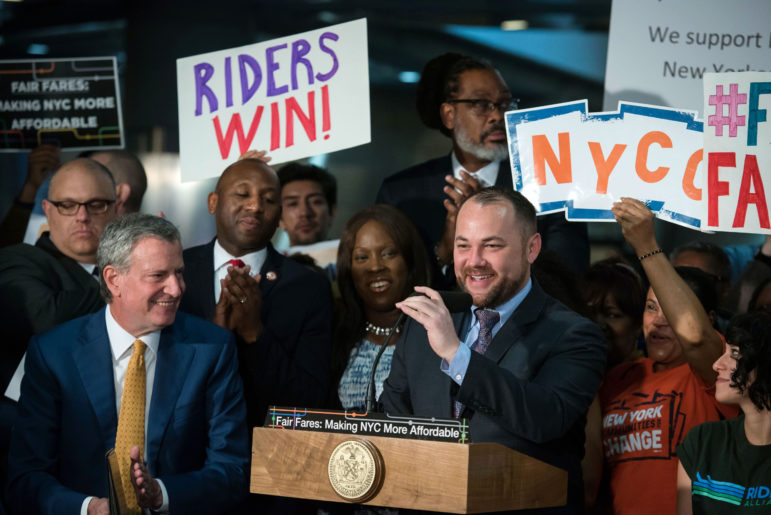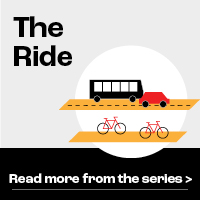
Flickr/NYCMayorsOffice
Mayor Bill de Blasio and Council Speaker Corey Johnson celebrate Fair Fares funding being included in the Budget in 2018.On Monday, the city launched open enrollment for its Fair Fares program, which provides half-priced MetroCards to low-income New Yorkers. The initiative launched at the start of 2019 but was rolled out in phases, first eligible only to those receiving certain public benefits and later expanding to cover low-income NYCHA residents, CUNY students and student veterans.
As of Jan. 27, any New Yorker who earns at or below the federal poverty level — you can find a list of household income requirements here — who isn’t already receiving a transit discount is able to apply for Fair Fares, according to city officials, who say more than 106,000 people have enrolled so far. They can also now apply online through a city website.
The program’s full rollout is a long-fought victory for transit and anti-poverty advocates. Groups like Riders Alliance and Community Service Society (a City Limits funder) pushed for years to get the city to approve Fair Fares, saying public transit costs are a hardship for many low-income New Yorkers. And while the MTA in recent months has put resources towards combating fare evaders, others want to expand the idea of low or no-cost public transit, including one City Councilmember who’s planning a bill that would offer free transit fares to “working class” city residents.
Among those who still hope to be included in Fair Fares are users of Access-a-Ride, the MTA-operated car service for New Yorkers with disabilities that make it hard or impossible for them to take the subway or bus. Those who use the program—which has been widely criticized for being inefficient and unreliable—pay $2.75 per trip on the service, the same as a full-fare public transit ride.
“For many people with disabilities, and senior citizens who are unable to use the subway and buses, Access-a-Ride is the only option,” says Christopher Schuyler, a senior staff attorney in the Disability Justice Program at New York Lawyers for the Public Interest, one of several advocacy groups pushing for Access-a-Ride reforms.
Advocates point out that only about a quarter of the MTA’s subway stations are equipped with elevators, meaning a majority of the system is inaccessible for riders with mobility issues. Even city buses, which are wheelchair accessible, pose their own hurdles.
If the program were extended to cover it, many Access-a-Ride users could potentially benefit from Fair Fares: 34 percent of working-age people with disabilities in New York City live at or below the poverty level, according to a 2019 state comptroller report, meeting the eligibility threshold for Fair Fares.
“Poverty and unemployment are disportionately high among people with disabilities,” Schuyler says. “Reliable and affordable transportation is essential when it comes to maintaining employment, accessing healthcare, just engaging in social events.”
A spokeswoman for the mayor’s office says the city is looking into the possibility of extending Fair Fares to eligible Access-a-Ride customers.
“Because public transportation is so important to the daily lives of New Yorkers, we are working with the MTA to identify options for Access-A-Ride users who would qualify for Fair Fares,” Avery Cohen said in a statement.
Another demographic group campaigning for discounted MetroCards is veterans. Though earlier phases of Fair Fares included low-income veterans who are also students, one former service member has been pushing for months to get lawmakers to move on a languishing state bill that would secure half-priced fares for all vets.
H.P. Schroer, a World War II veteran and advocate, has been contacting lawmakers and testifying at MTA board meetings to plug the legislation—sponsored by Jeffrey Dinowitz in the Assembly and John Brooks in the Senate—which would require the state to allocate funds to cover the veterans’ discounts.
“The state is where it should be done. The city took the first step—now it’s up to the state to go one step further,” says Schroer.
According to the bill, New York’s veteran numbers have dropped by more than 30 percent between 2000 and 2015—a decrease that’s likely due to an aging veteran population, but one Schroer also attributes to “the high costs of living and transportation” here. About 10 percent of the city’s more than 200,000 veterans live below the poverty line, data shows.
Schroer is hoping the bill will come up for a vote by the end of the current session. An earlier version of the legislation passed in the Senate, but not the Assembly.
“I want it to happen during my lifetime, for the younger veterans,” he says, adding that at 93, he’s already eligible for his own half-priced senior MetroCard offered by the MTA. “What is the moral obligation for those who have sacrificed and served?”









